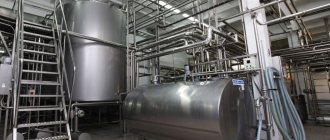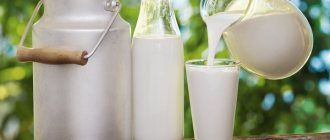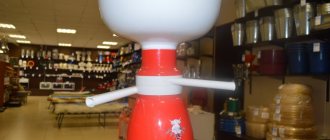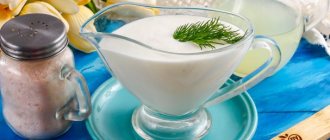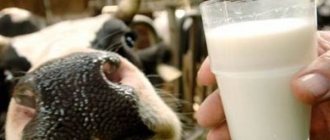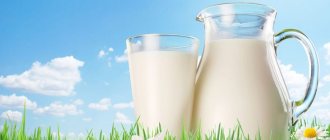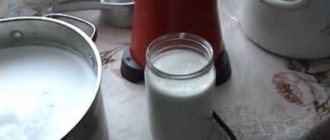On packages of store-bought milk you can see inscriptions such as: sterilized, pasteurized and ultra-pasteurized milk.
What do they all mean? In what way will milk processed for human consumption be tastier and healthier?
Milk is a unique drink with a healthy set of nutrients - proteins, fats, carbohydrates, vitamins, mineral salts.
Therefore, knowing what kind of processing it goes through before it hits store shelves is very important.
Ultra-high temperature sterilization (UHT)
Milk is sterilized at a temperature of 135-150°C for 2 seconds. The double action of high temperatures causes more noticeable changes in the components of milk than sterilization in a single-stage mode. However, the product obtained in this way is very stable and can be stored in unrefrigerated areas for more than a year.
Thus, it is advisable to use a one-stage sterilization regime when producing milk for local consumption. If the product must be transported over long distances or stored for a long time, a two-stage sterilization regime must be used.
After all the main procedures, the first stage of two-stage milk sterilization is carried out. Milk prepared for sterilization enters a tubular sterilizer, is heated to 135-140°C and maintained at this temperature in a sterilizer for 2-4 seconds. Sterilized milk must be homogenized to improve its properties.
Ways to distinguish pasteurized milk from sterilized
We have already talked about the difference between pasteurized and sterilized milk. It’s easy to understand what kind of product is in front of you; the manufacturer must indicate the processing method on the packaging. Fermented milk products are made from pasteurized raw materials, which means they retain beneficial microorganisms. It is almost impossible to ferment sterilized milk due to the lack of bacteria in it.
Pasteurized and sterilized milk differ in color. Due to high-temperature processing, it acquires a beige, or less often, brown tint.
These products also taste different. Sterilized milk has a specific boiled taste that occurs due to prolonged high-temperature treatment.
The presence of the smell of a cow, by the way, does not indicate the high quality of the product. Most likely, it will be pasteurized, but the presence of an odor indicates both low-quality pasteurization and the use of poorly purified raw materials.
Milk homogenization
Homogenization is the process of crushing (dispersing) fat globules so that there is no sludge during storage. In the original milk, the diameter of fat globules ranges from 0.5 to 18 microns, on average it is 2-4 microns. In homogenized milk, the diameter of the fat globules is about 1 µm.
As a result of the uniform distribution of fat throughout the mass, the viscosity of homogenized milk increases.
Milk can be homogenized at various temperatures, starting from the melting point of the milk fat. At temperatures below 30°C, satisfactory results cannot be obtained, since the milk fat is not in a liquid state. As the temperature increases from 30 to 65°C, the homogenization effect increases. The best results are obtained at 60-65°C, pressure 15-20 MPa. The process is carried out using special devices - homogenizers.
After the homogenizer, the milk is returned to the sterilization unit, where it is cooled to 35+-5°C and stored in an intermediate container. The purpose of cooling is to prepare milk for bottling and capping.
Stages of pasteurization at home
If you are going to make cheese, we will tell you how to pasteurize milk at home:
- Pour the milk into a saucepan and heat over medium heat, stirring constantly. Check the temperature of the milk with a thermometer. Wait until it reaches 72-75 degrees.
- Cover the pan with a lid and let it sit for 30 seconds to 1 minute.
- After this, place the pan in a container filled with cold water so that the milk quickly reaches room temperature (depending on the type of cheese you are going to make - 22-38 degrees), after which you can start making cheese.
If the task is how to pasteurize milk at home for storage and consumption, it is necessary to carry out long-term pasteurization. To do this, it is convenient to use kitchen appliances: a multicooker, a double boiler, a microwave oven or a milk boiler. Such equipment “with brains” is already programmed to work at a certain temperature for the required time. The housewife does not need to constantly monitor the process; the devices will correctly pasteurize milk at home, as if it were happening in production under the supervision of an experienced technologist.
How to pasteurize milk in a slow cooker
Pasteurizing milk in a slow cooker is a simple process. It is enough to pour fresh milk directly into the bowl and turn on the “Multi-cook” or “Keep warm” mode with a heating temperature of 80 degrees and a timer of 20 minutes for each liter of milk. Some models of multicookers have a “Pasteurization” mode, so there is no need to set operating parameters in them. After the signal, immediately take out the cup, pour it into prepared sterile containers and cool.
Milk can be pasteurized in a milk cooker
The milk cooker that you can buy today is, at first glance, a saucepan with a double bottom, shaped like a huge mug or ladle. The main feature of this device is its double body, the space between the walls of which is filled with water. For this purpose, a special hole is provided on top, which is closed during operation with a plug with or without a whistle.
Before filling the milk cooker with milk, remove the plug and pour water into the space between the walls. The volume of liquid depends on the size of your pan. After filling, it is recommended to tilt it at an angle of 45 degrees so that some of the water spills out and does not splash out of the “spout” during boiling. Next, the hole is closed with a stopper, milk is poured in and pasteurization of the milk in the milk cooker begins until the whistle blows or the temperature of the milk is monitored with a thermometer.
Filling and capping
Before bottling, the milk is heated to 65-70°C and flows by gravity into a filling and capping machine for packing milk into narrow-neck 0.5 liter bottles. The bottles are pre-washed and disinfected in a bottle-washing machine; they enter the filling and capping machine at a temperature of 60°C. This prevents thermal breakage of the bottles. Since the volume of milk may increase during subsequent sterilization, bottles are not filled to 4-8 cm. The bottles are hermetically sealed with crown cork stoppers.
What does "whole" mean?
First, let’s define what the “whole” marking means. According to this parameter, all milk used in industrial production is divided into 2 large groups:
- Reconstituted - created from powder, milk powder. That is, the original raw material is completely dehydrated for ease of storage, and then again saturated with water. The resulting product is practically indistinguishable in appearance and even taste from “regular” milk. Its main drawback is the minimal content of useful substances, since they all disappear during processing.
- Whole - produced from liquid raw materials supplied to the dairy directly from farms. Usually it acts as an intermediate link between raw milk (from under a cow) and ready-to-drink, “store-bought” milk. But sometimes, not very often, it can be found on sale and in retail.
The second important difference is easiest to understand with a simple example. The standard algorithm for the production of drinking milk, which is familiar to most people, in a simplified form consists of the following steps:
- mixing raw materials from different cows,
- normalization - bringing the fat content of the mixture to “standard” values of 2.5% or 3.2% by adding cream or skim milk,
- heat treatment,
- package,
- sending to stores.
The main difference between whole milk is the absence of a normalization stage. That is, the finished product, packaged in a standard milk carton, does not have the usual “fixed” fat content. Like raw milk, it can vary slightly, so the fat content is usually indicated on the packaging within certain limits. Here, for example, is the marking on a box of whole milk “Milk Spring”:
In this case, the heat treatment procedure cannot be skipped, and in this case, sterilization technology is used.
Storage of the finished product
Sterilized milk is stored at an air temperature in the chamber no higher than 20°C and a relative air humidity of 85-90%. Storage rooms must be kept strictly clean and air ventilated. Sterilized milk using a two-stage sterilization method can be stored in uncooled areas for more than 1 year.
Sterilized milk is delivered to retail chains and catering establishments in vehicles with refrigerated or isothermal bodies. It is allowed to transport sterilized milk in open cars, but with the obligatory covering of the product with a tarpaulin or material replacing it.
Technical specialists of BESTEK-Engineering LLC are ready to offer you assistance in selecting the correct equipment for milk sterilization for the performance you require.
Possible harm
Potential harm to the product mainly stems from the fact that chemicals may be added to extend shelf life.
As a result of pasteurization, up to 90% of the vegetative forms of bacteria that live in milk die. The problem is that only those microorganisms that are in an active state are destroyed. Their spores remain viable (although they cannot withstand ultra-pasteurization). After entering the human body, when more or less favorable conditions appear, they will begin to multiply quickly. Therefore, pasteurized milk should be stored correctly - at a cool temperature and no longer than the period indicated on the package. Otherwise, consuming the product may result in poisoning and other negative reactions of the body.
We can conclude that pasteurized milk is not completely neutralized. It would be more correct to call it a product with an extended shelf life. If storage conditions are met and the milk itself is of high quality, then it carries no more health risks than fresh milk.
Hidden threats to children
Pasteurized milk is optimal for baby food. It does not contain harmful preservatives that provoke allergic reactions, including diathesis.
There is also a warning for parents. It is recommended for children to prepare porridge with pasteurized milk only from the age of 6-7 years. After 1 year, the baby can drink it, but not earlier.
It is better to boil pasteurized milk for a child. During the heat treatment at the factory, some microorganisms covered with a resistant film are not destroyed. They are safe for adults, but children's bodies are more sensitive.
How to choose the right milk for making cheese
If you manage to find a farmer from whom it is convenient to purchase raw materials, then you should check its quality:
- Milk must not be pasteurized. We are talking about the absence of factory pasteurization. In principle, 9 out of 10 farmers sell unpasteurized milk. But even gentle pasteurization done by the farmer in order to extend the shelf life of milk will not greatly spoil the recipe of the future cheese.
- We buy only fresh milk. It is highly undesirable to use yesterday’s product or one that is already more than 12 hours old in the process of making cheese. From the moment the milk is released to the start of making the cheese, 4-5 hours should pass.
- Dairy raw materials must be visually clean, without any foreign substances.
- It sounds corny, but milk should smell like milk! Foreign odors will be transferred to the future cheese.
- Milk should not be frozen - this is especially important in winter.
- And no water! This is exactly what many unscrupulous farmers do.
Speaking about choosing store-bought milk for cheese, we pay attention to the following nuances:
Read also: Shift rate. Calculation. Example
- We give preference to a product enclosed in light-proof packaging - it preserves vitamins longer.
- We check the tightness of the packaging. Violation of the integrity of the container is a sign of staleness of the product.
- Be sure, we repeat, be sure to look at the date of manufacture and shelf life.
- Well, you shouldn’t buy a product if there is no label on it or it is in a foreign language.

